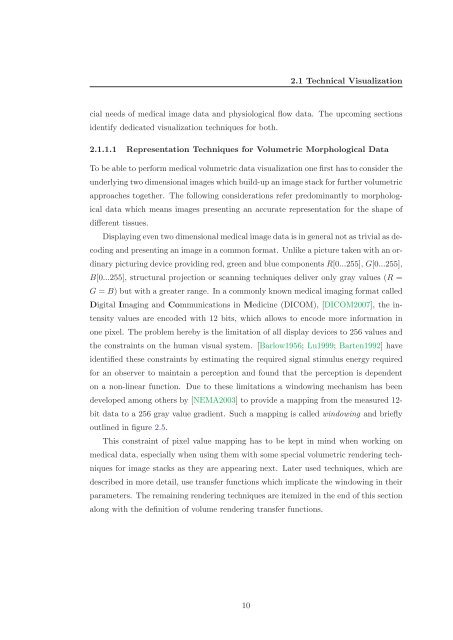Master's Thesis - Studierstube Augmented Reality Project - Graz ...
Master's Thesis - Studierstube Augmented Reality Project - Graz ...
Master's Thesis - Studierstube Augmented Reality Project - Graz ...
Create successful ePaper yourself
Turn your PDF publications into a flip-book with our unique Google optimized e-Paper software.
2.1 Technical Visualization<br />
cial needs of medical image data and physiological flow data. The upcoming sections<br />
identify dedicated visualization techniques for both.<br />
2.1.1.1 Representation Techniques for Volumetric Morphological Data<br />
To be able to perform medical volumetric data visualization one first has to consider the<br />
underlying two dimensional images which build-up an image stack for further volumetric<br />
approaches together. The following considerations refer predominantly to morphological<br />
data which means images presenting an accurate representation for the shape of<br />
different tissues.<br />
Displaying even two dimensional medical image data is in general not as trivial as decoding<br />
and presenting an image in a common format. Unlike a picture taken with an ordinary<br />
picturing device providing red, green and blue components R[0...255], G[0...255],<br />
B[0...255], structural projection or scanning techniques deliver only gray values (R =<br />
G = B) but with a greater range. In a commonly known medical imaging format called<br />
Digital Imaging and Communications in Medicine (DICOM), [DICOM2007], the intensity<br />
values are encoded with 12 bits, which allows to encode more information in<br />
one pixel. The problem hereby is the limitation of all display devices to 256 values and<br />
the constraints on the human visual system. [Barlow1956; Lu1999; Barten1992] have<br />
identified these constraints by estimating the required signal stimulus energy required<br />
for an observer to maintain a perception and found that the perception is dependent<br />
on a non-linear function. Due to these limitations a windowing mechanism has been<br />
developed among others by [NEMA2003] to provide a mapping from the measured 12-<br />
bit data to a 256 gray value gradient. Such a mapping is called windowing and briefly<br />
outlined in figure 2.5.<br />
This constraint of pixel value mapping has to be kept in mind when working on<br />
medical data, especially when using them with some special volumetric rendering techniques<br />
for image stacks as they are appearing next. Later used techniques, which are<br />
described in more detail, use transfer functions which implicate the windowing in their<br />
parameters. The remaining rendering techniques are itemized in the end of this section<br />
along with the definition of volume rendering transfer functions.<br />
10





